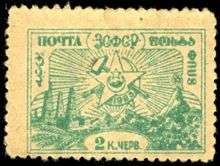Transcaucasian Socialist Federative Soviet Republic
| Transcaucasian Socialist Federative Soviet Republic | ||||||
| | ||||||
| ||||||
| ||||||
 Location of the Transcaucasian SFSR within the Soviet Union | ||||||
| Capital | Tbilisi | |||||
| Languages | Georgian Azerbaijani Armenian Russian | |||||
| Government | Soviet socialist republic | |||||
| History | ||||||
| • | Established | 12 March 1922 | ||||
| • | Disestablished | 5 December 1936 | ||||
| Area | ||||||
| • | 1922 | 186,100 km² (71,854 sq mi) | ||||
| Currency | Transcaucasian ruble, Soviet ruble | |||||
| Today part of | | |||||
The Transcaucasian Socialist Federative Soviet Republic (Transcaucasian SFSR or TSFSR), also known as the Transcaucasian Soviet Federative Socialist Republic, was a constituent republic of the Soviet Union that existed from 1922 to 1936.[1][2] It embraced Armenia, Azerbaijan and Georgia. As they were separated from Russia by the Caucasus Mountains, they were known traditionally as the Transcaucasian Republics.
Names in the local languages
- Armenian: Անդրկովկասի Խորհրդային Սոցիալիստական Դաշնային (Ֆեդերատիվ) Հանրապետություն
- Andrkovkasi Khorhrdayin Soc‘ialistakan Dashnayin (Federativ) Hanrapetut‘yun
- Azerbaijani: Загафгазија Сосиалист Федератив Совет Республикасы
- Zaqafqaziya Sosialist Federativ Sovet Respublikası
- Georgian: ამიერკავკასიის საბჭოთა ფედერაციული სოციალისტური რესპუბლიკა
- Amierk'avk'asiis Sabch'ota Pederatsiuli Sotsialist'uri Resp'ublik'a
- Russian: Закавказская Социалистическая Федеративная Советская Республика (ЗСФСР)
- Zakavkazskaya Sotsalisticheskaya Federativnaya Sovetskaya Respublika (ZSFSR)
History
The roots of a Transcaucasian condominium state trace back to the dissolution of the Russian Empire in 1918, following the October Revolution, when the provinces of the Caucasus seceded and formed their own state called the Transcaucasian Federation. Competing ethno-national interests and confrontation with the Ottoman Empire in World War I led to the dissolution of the Transcaucasian Federation only two months later, in April 1918.
The three successor states: the First Republic of Armenia, the Democratic Republic of Azerbaijan, and the Democratic Republic of Georgia, lasted until the end of the Russian civil war that was being fought across the mountains, when they were invaded by the Red Army and sovietized. Following the proposal by Vladimir Lenin the three now Soviet Republics, the Armenian, Azerbaijani and Georgian SSRs, were united into the Federative Union of Socialist Soviet Republics of Transcaucasia on March 12, 1922. In the same year, on December 13, the First Transcaucasian Congress of Soviets transformed this federation of states into a federative state and renamed it into the Transcaucasian Socialist Federative Soviet Republic, though keeping formally the autonomy of the constituent republics. The congress also adopted the constitution, appointed the Central Executive Committee (the highest legislative body), and the Council of People's Commissars (the government). Mamia Orakhelashvili, a Georgian Bolshevik leader, became the first chairman of the Transcaucasian SFSR Council of People’s Commissars.[3] Tbilisi was the capital of the republic.
The republic became a founding member of the Soviet Union on December 30 along with the Russian SFSR, the Ukrainian SSR, and the Byelorussian SSR. In 1936, the Transcaucasian SFSR was dissolved and divided again among the Georgian, Armenian and Azerbaijani SSRs.[1][2]
Autonomous republics within TSFSR
.jpg)
After the Red Army invasion of Georgia, Abkhazia, hitherto an autonomous province within the Democratic Republic of Georgia, was declared a Soviet Republic, the SSR of Abkhazia, in March 1921 by the Abkhaz Revolutionary committee. However the republic's relations with Georgia and Russia were not formally settled.[4] On December 16, 1921, Abkhazia signed a treaty of alliance with the Georgian SSR, which defined its status as a treaty republic (Russian: договорная республика) and established a military, political and financial union between the two Soviet republics, subordinating the SSR of Abkhazia to the Georgian SSR. Thus, through Georgia, Abkhazia joined the TSFSR and was initially on an equal footing with the other republics of the federation.[5][6] On February 19, 1931, Abkhazia’s republican status was downgraded, on the orders of Joseph Stalin, to that of an Autonomous Soviet Socialist Republic within the Georgian SSR.[7]
The Adjar ASSR was established on July 16, 1921 within the Georgian SSR as a consequence of the Treaty of Kars. The treaty marking the end of the Caucasus Campaign in the World War I provided for the division of the former Batum Oblast of the Kutaisi Governorate of the Russian Empire between Georgia and Turkey. According to the agreement the northern half with significant Georgian Muslim population would become part of the Soviet Georgia but granted autonomy.
Another autonomous republic was established in July 1920 in Nakhchivan, an area bordering Armenia, Turkey and Iran, which was claimed by Armenians and Azerbaijanis. After the occupation of the region by the Red Army, the Nakhchivan Autonomous Soviet Socialist Republic was declared with "close ties" to the Azerbaijani SSR. The Treaty of Moscow and the Treaty of Kars affirmed the establishment of the autonomous republic as part of the Soviet Azerbaijan.[8]
Heads of state
| Name | Dates | Party |
|---|---|---|
| Nariman Narimanov | March–December 1922 | Communist Party of Azerbaijan |
| Polikarp Mdivani | March–December 1922 | Communist Party of Georgia |
| Aleksandr Myasnikyan | March–December 1922 | Communist Party of Armenia |
| Name | Dates | Party |
|---|---|---|
| Nariman Narimanov | 1922-1925 | Communist Party of Azerbaijan |
| Gazanfar Musabekov | 1925-1938 | Communist Party of Azerbaijan |
| Name | Period | For |
|---|---|---|
| Mikhail Tskhakaya (1st time) | 1922–1927 | Georgia |
| Samad aga Aliyev | 1922–1929 | Azerbaijan |
| Sarkis Ambartsumyan | 1922–1925 | Armenia |
| Sarkis Kasyan | 1927–1931 | Armenia |
| Filipp Makharadze (1st time) | 1927–1928 | Georgia |
| Mikhail Tskhakaya (2nd time) | 1928–1931 | Georgia |
| Gazanfar Musabekov | 1929–1931 | Azerbaijan |
| Filipp Makharadze (2nd time) | 1931–1935 | Georgia |
| Armenek Ananjan | 1931–1935 | Armenia |
| Sultan Majid Afandiyev | 1931–1936 | Azerbaijan |
| Sergo Martikiyan | 1935–1936 | Armenia |
| Avel Enukidze | March–May 1935 | Georgia |
| Filipp Makharadze (3rd time) | 1935–1936 | Georgia |
Stamps and postal history

Before 1923, each of Georgia, Armenia, and Azerbaijan issued its own postage stamps. The Federation began issuing its own stamps on September 15, 1923, and superseded the separate republics' issues on October 1. The first issues consisted of some of the stamps of Russia and Armenia overprinted with a star containing the five-letter acronym of the federation inside the points. Massive inflation having set in, this was followed by an issue of the Federation's own designs, four values of a view of oil fields, and four with a montage of Soviet symbols over mountains and oil derricks, values ranging from 40,000 to 500,000 rubles. The 40,000 руб and 75,000 руб were then surcharged to 700,000 rubles. On October 24, the stamps were re-issued with values from 1 to 18 gold kopecks. Starting in 1924, the Federation used stamps of the Soviet Union.
Most of the stamps of the Federation are not especially rare today, with 1998 prices in the US$1–2 range, although the overprints on Armenian stamps range up to US$200. As might be expected from a short period of usage, used stamps are less common than unused and covers are not often seen.
See also
- Kars Republic
- Mountainous Republic of the Northern Caucasus
- Lithuanian–Belorussian Soviet Socialist Republic
- Far Eastern Republic
- Don Republic
- Kuban People's Republic
- Bavarian Soviet Republic
- Republics of the Soviet Union
- Komancza Republic
References
- 1 2 "The Soviet Period - History - Azerbaijan - Asia". Retrieved 25 July 2011.
- 1 2 Закавказская федерация. Большая советская энциклопедия, 3-е изд., гл. ред. А. М. Прохоров. Москва: Советская энциклопедия, 1972. Т. 9 (A. M. Prokhorov; et al., eds. (1972). "Transcaucasian Federation". Great Soviet Encyclopedia (in Russian) 9. Moscow: Soviet Encyclopedia.)
- ↑ Suny, Ronald Grigor (1994), The Making of the Georgian Nation: 2nd edition, p. 235. Indiana University Press, ISBN 0-253-20915-3.
- ↑ Declaration of the Revolutionary Committee of the Soviet Socialist Republic of Georgia on Independence of the Soviet Socialist Republic of Abkhazia. May 21, 1921. Regionalism Research Center, February 4, 2008.
- ↑ Bell, Imogen (2002), Eastern Europe, Russia and Central Asia, p. 176. Taylor & Francis, ISBN 1-85743-137-5.
- ↑ Jones, Stephen F. (Oct., 1988), The Establishment of Soviet Power in Transcaucasia: The Case of Georgia 1921-1928. Soviet Studies, Vol. 40, No. 4, pp. 616-639.
- ↑ Lang, David Marshall (1962), A Modern History of Georgia, p. 256. London: Weidenfeld and Nicolson.
- ↑ Text of the Treaty of Kars
| ||||||||||||||||||||

.svg.png)
